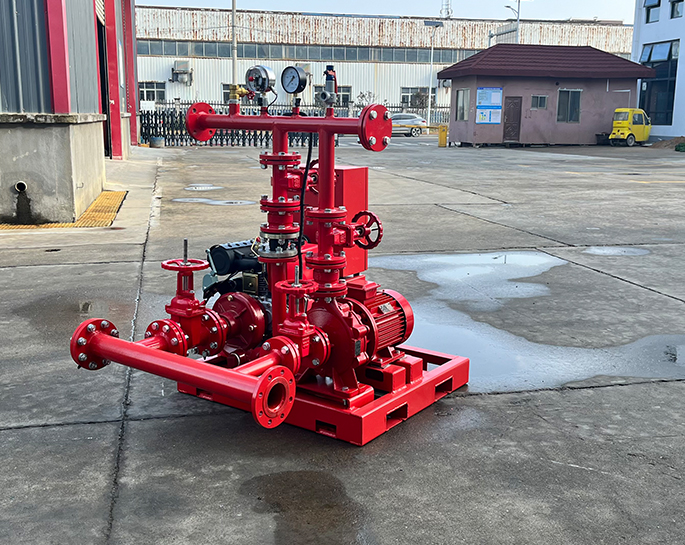How are fire pump controllers synchronized in multi-pump systems for efficient operation?
Jan 11, 2024
Share:
Synchronizing fire pump controllers in multi-pump systems is crucial for efficient and reliable operation. Synchronization ensures that multiple pumps work together seamlessly to provide a consistent and reliable water supply for fire protection systems. Here's an overview of how fire pump controllers are synchronized in multi-pump systems:
### Methods for Synchronizing Fire Pump Controllers:
1. **Speed Control:**
- In multi-pump systems, pumps are often synchronized based on their rotational speed. Speed control involves adjusting the speed of each pump motor to match a reference speed.
- Electronic speed control systems, such as variable frequency drives (VFDs), are commonly used for precise speed adjustment.
2. **Pressure Control:**
- Synchronization based on pressure control involves adjusting the output of each pump to maintain a consistent pressure in the system.
- Pressure sensors and controllers monitor the system pressure, and each pump controller adjusts its output to maintain the desired pressure level.
3. **Flow Control:**
- Synchronization based on flow control focuses on matching the flow rates of individual pumps to ensure an even distribution of water throughout the fire protection system.
- Flow sensors and controllers measure the flow rates, and adjustments are made to achieve a balanced flow from each pump.
4. **Load Sharing:**
- Load-sharing systems distribute the load among multiple pumps to prevent overloading of any single pump. Each pump controller monitors its load and adjusts accordingly to share the overall demand.
- Load-sharing can be achieved through communication between controllers and the use of load-sharing algorithms.
5. **Communication Systems:**
- Fire pump controllers in multi-pump systems often use communication protocols to exchange information. This allows controllers to coordinate their actions and make real-time adjustments based on system requirements.
- Common communication protocols include Modbus, Profibus, or proprietary protocols specific to the manufacturer.
### Key Considerations for Efficient Synchronization:
1. **Redundancy:**
- Redundancy in communication and control systems is essential to ensure continued operation in case of a controller or communication failure.
2. **Automatic Failover:**
- Systems may include automatic failover mechanisms to transition control to a backup pump or controller if a primary component malfunctions.
3. **Load Balancing:**
- Even load distribution among pumps helps prevent uneven wear and tear and ensures that each pump operates within its optimal range.
4. **Synchronization Algorithms:**
- Manufacturers often implement advanced synchronization algorithms that take into account factors such as pump characteristics, system demand, and response time.
5. **Continuous Monitoring:**
- Continuous monitoring of pump performance, system pressure, and other relevant parameters is essential for detecting and addressing any deviations from the desired synchronization.
Efficient synchronization of fire pump controllers in multi-pump systems enhances the reliability and performance of fire protection systems, ensuring a timely and effective response in the event of a fire.

### Methods for Synchronizing Fire Pump Controllers:
1. **Speed Control:**
- In multi-pump systems, pumps are often synchronized based on their rotational speed. Speed control involves adjusting the speed of each pump motor to match a reference speed.
- Electronic speed control systems, such as variable frequency drives (VFDs), are commonly used for precise speed adjustment.
2. **Pressure Control:**
- Synchronization based on pressure control involves adjusting the output of each pump to maintain a consistent pressure in the system.
- Pressure sensors and controllers monitor the system pressure, and each pump controller adjusts its output to maintain the desired pressure level.
3. **Flow Control:**
- Synchronization based on flow control focuses on matching the flow rates of individual pumps to ensure an even distribution of water throughout the fire protection system.
- Flow sensors and controllers measure the flow rates, and adjustments are made to achieve a balanced flow from each pump.
4. **Load Sharing:**
- Load-sharing systems distribute the load among multiple pumps to prevent overloading of any single pump. Each pump controller monitors its load and adjusts accordingly to share the overall demand.
- Load-sharing can be achieved through communication between controllers and the use of load-sharing algorithms.
5. **Communication Systems:**
- Fire pump controllers in multi-pump systems often use communication protocols to exchange information. This allows controllers to coordinate their actions and make real-time adjustments based on system requirements.
- Common communication protocols include Modbus, Profibus, or proprietary protocols specific to the manufacturer.
### Key Considerations for Efficient Synchronization:
1. **Redundancy:**
- Redundancy in communication and control systems is essential to ensure continued operation in case of a controller or communication failure.
2. **Automatic Failover:**
- Systems may include automatic failover mechanisms to transition control to a backup pump or controller if a primary component malfunctions.
3. **Load Balancing:**
- Even load distribution among pumps helps prevent uneven wear and tear and ensures that each pump operates within its optimal range.
4. **Synchronization Algorithms:**
- Manufacturers often implement advanced synchronization algorithms that take into account factors such as pump characteristics, system demand, and response time.
5. **Continuous Monitoring:**
- Continuous monitoring of pump performance, system pressure, and other relevant parameters is essential for detecting and addressing any deviations from the desired synchronization.
Efficient synchronization of fire pump controllers in multi-pump systems enhances the reliability and performance of fire protection systems, ensuring a timely and effective response in the event of a fire.


.png)
.png)

.png)


